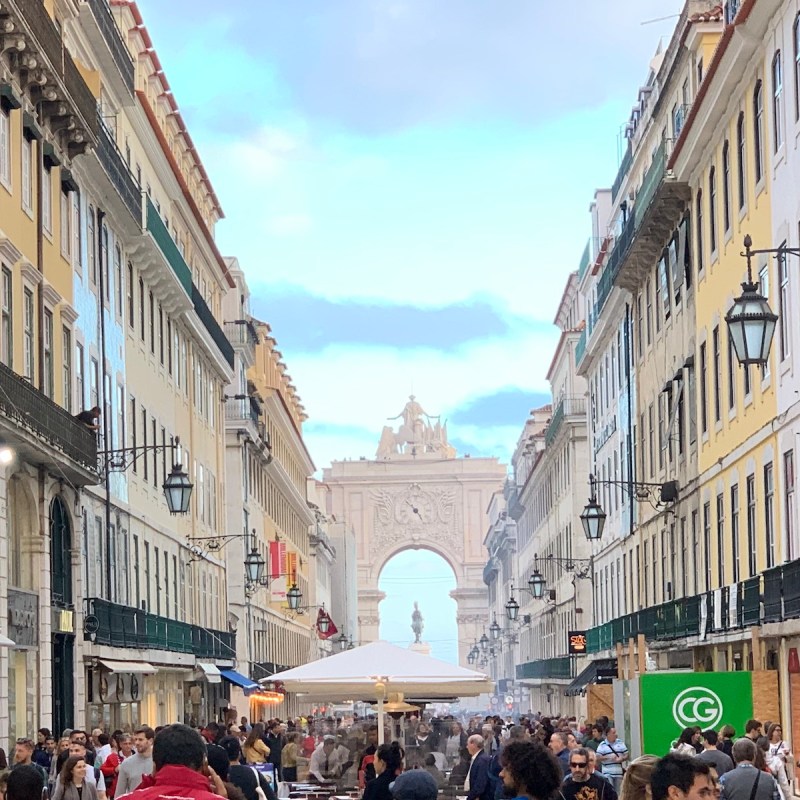
Lisbon, the vibrant and varied capital city of Portugal, has many different neighborhoods each with a unique character. From elegant shopping in Avenida de Liberdade to a buzzy nightlife in Bairro Alto, the vibe of Lisbon’s various quarters can provide ample opportunity to experience the many faces of Portugal’s hilly heartbeat of a city during one visit. We’ll share some of what we think are the most unique neighborhoods to explore in Lisbon and provide some insight as to what you might expect to find when you’re there.
Videos by TravelAwaits

1. Cais Do Sodré
A great introduction to Lisbon’s diverse neighborhoods is the multicultural melting pot of Cais do Sodré. This is where the Linha de Cascais, the train that comes from the beach towns west of the city, finishes its Lisbon-bound route. Boats also arrive daily with people from all over.
A great spot for nightlife, Pink Street is a sweet spot for bars, restaurants, and socializing. There’s plenty to do during the daytime as well, with cafés, restaurants, and a wide array of shops. Food lovers will gravitate toward Time Out Market Lisboa, where you can sample local dishes — some from several Michelin-starred chefs — and visit the fabulous fresh market right next door.
2. Chiado
Cosmopolitan and architecturally significant, Chiado is where a lot of Portuguese do their shopping. The gateway between other neighborhoods, like Baixa and Cais do Sodré, Chiado’s history includes places where Portugal’s most famous literary figures, such as Fernando Pessoa and José Maria Eça de Queiroz, used to hang out and write at cafés like A Brasileira.
It’s not surprising that Livraria Bertrand, the world’s oldest bookstore, is here. Other important features of Chiado include the National Museum of Contemporary Art, the Largo do Carmo, and the Convento Do Carmo — now a museum. Public transportation will include Baixa to Chiado as one stop, where going up leads to Chiado and heading down goes to Baixa.

3. Baixa
Destroyed in the great 18th-century earthquake of 1755, Baixa is one of the best neighborhoods for seeing Lisbon as it arose from the ashes in urban planning for the first time and new buildings designed to withstand seismic activity — another first. The crossroads between Praça do Comércio at the Tagus River, Cais do Sodré, Rossio Square, Chiado and the Carmo, and Castelo de São Jorge could be considered the city’s center.
Centered around Rua Augusta with its magnificent arch, the streets became a hub for merchants, artisans, and customers. Many of the streets today are for pedestrians only and link to the major squares. Elevador de Santa Justa, designed by a student of Gustav Eiffel, takes you up from Baixa to Chiado with a lovely view of the city.

4. Alfama
The oldest neighborhood in Lisbon and one of the oldest in Europe, Alfama offers a look into Portugal’s medieval past. Narrow streets wind through steep hills lined with shops and cafés. A favorite way to avoid too much climbing and to see the area up close is to take a ride on Tram No. 28, which goes through many of the historic spots on its way up to São Jorge Castle.
Alfama became home to the city’s poorer residents and a hub for the seafaring class. Out of this grew the famed fado music, Portugal’s haunting moody melodies of love, loss, longing, and saudade. Though becoming more modern, Alfama still has much of its magic. A visit to one of the traditional fado houses in the area will create lasting memories.
5. Principe Real
For a neighborhood that has become popular not only as a place to visit but also as a place to live, the fashionable Principe Real is a great spot. Although primarily residential, the charming area is full of palaces, antique shops, museums, and gardens. It was named after Dom Pedro V, who liked to take long walks through the area; an excellent idea.
Boutique shops and trendy restaurants have popped up all over the neighborhood and the lovely Principe Real Garden is a park offering beautiful and unique miradouros, or viewpoints of the city. There’s an upscale artist vibe that also shines with the Saturday morning eco-friendly farmers market that focuses on selling organic and sustainable products.
6. Bairro Alto
For night owls who want a ton of options to light up the night, Bairro Alto is the place. Restaurants, bars, and fado houses are filled to the brim with people out to enjoy a bustling nightlife. Since many of the establishments are small, the streets often overflow with people who mix and mingle even on the hilly, narrow streets, enjoying the festive, Bohemian air.
Surprisingly, it’s not that busy during the day, and though pretty quiet, there has been a renaissance of restoration, with buildings filled with new stores, studios, and tattoo parlors. Like the Greenwich Village of Lisbon, there are delights to discover around every corner.

7. Parque Das Nações
We recently explored this exciting “Park of Nations” neighborhood when we took a break during the massive WebSummit held annually at the Altice Arena in Lisbon. This 5-kilometer (3.1-mile) strip along the Tagus River is also known as Oriente — a modern area filled with recreational and cultural opportunities.
Contemporary architecture, some with a nautical bent, provides the perfect backdrop for the amazing Lisbon Oceanarium. We could have spent all day watching the huge aquarium as well as otters, penguins, and other animal friends.
It is a great urban and street art district, including Bordalo II’s fantastic Iberian Linx sculpture made with trash, as well as the Vasco de Gama shopping center close by. For a quick but fun ride, take the Telecabine over the Tagus River with panoramic views from 30 meters (98.4 feet) above.
Pro Tip: You can purchase tickets for the Telecabine together with tickets at the oceanarium to save time.

8. Belém
The Age of Discovery, or Portugal’s Golden Age, is beautifully represented in Belém. At the westernmost edge of Lisbon, it’s either the first neighborhood on your way in or the last on your way out, depending on which way you’re headed. And it’s well worth a visit for the vast number of significant monuments here.
The Padrão dos Descobrimentos (Monument to the Discoveries) features 32 important Portuguese figures from the time including Henry the Navigator, Vasco de Gama, and Ferdinand Magellan among them. The Torre de Belém (Belém Tower) and Mosteiro dos Jerónimos (Jerónimos Monastery) are also prime attractions. The Museu Coleção Berardo and the Museum of Art, Architecture, and Technology (MAAT) are two of the prominent museums and galleries here. But a visit to Belém would not be complete without a taste of the most famous egg tart from the Pasteis De Belém bakery next to the monastery.
Pro Tip: The line can get long at the bakery, so for a real treat, go inside and have a seat in one of the many large rooms inside. There you can order in comfort and relax with a variety of beverages and other treats as well.
9. Mouraria
One of Portugal’s most multicultural neighborhoods, Mouraria — also known as the Moorish Quarter — has an interesting history. Even though King Afonso Henriques captured Lisbon in the 12th century, he let the Moors remain there. Now, some 50 different nationalities call the area home.
Mouraria is the birthplace of fado music. Its first lady of song, Amalia, as well as the modern face of fado, Mariza, both called the neighborhood home. The Martim Moniz Square is a popular spot to try some authentic cuisines from around the world including Bangladeshi, Chinese, African, Japanese, and more. A large dragon sculpture made of old cell phones was erected as a tribute to the Chinese year of the dragon in this funky, soulful, and diverse area.

10. Graça
For those looking for great views from up high, Graça is the perfect spot. In fact, it’s one of the highest hilltops in Lisbon. The views at Miradouro de Nossa Senhora Do Monte and Miradouro da Graça are spectacular, but it is a way’s up. If you take your time and want to enjoy the sites and shops on the way, take it slow and enjoy. Otherwise, hop on the Tram No. 28 to get there.
The neighborhood is not only historical but also quite traditional. There’s a feeling of Portuguese continuity that’s quite captivating, especially when taking a little time to stop and look out over the city from the magnificent panoramic viewpoints. There’s also a lot of street art worth noting in Graça. Though you won’t find many hotels nearby, there are some lovely apartment rentals as well as lots of great local restaurants to enjoy an authentic taste of the neighborhood.
11. Avenida Da Liberdade
Strolling through Avenida Da Liberdade is like walking along the boulevards of Paris. Perhaps that’s because Paris served as its inspiration. Kiosks with coffee and wine dot the wide, tree-lined streets, inviting visitors to stop and unwind. And that may be necessary after a long day of high-end shopping in one of the best areas in Lisbon for nabbing those luxury items. Gucci, Prada, Louis Vuitton, Cartier, Miu Miu, Versace, Emporio Armani, Bulgari, Dior, and many more big, beautiful brands line the avenue.
Excellent restaurants offer just about any dining experience imaginable, from Michelin-starred Chef Joaquim Koerper’s Eleven, sushi, Italian, Portuguese, and even a Hard Rock Cafe. Accommodations include five-star elegance and beautiful boutique hotels. For those seeking a chic retreat of retail therapy and luxury, Avenida da Liberdade is a perfect fit.
Lisbon is a city with so much to enjoy that it’s worthwhile exploring a variety of its unique neighborhoods. These are just a few that we think are worth visiting. Make sure to book a stay at one of the best hotels in Lisbon for your next trip to Portugal.
Related Reading:
